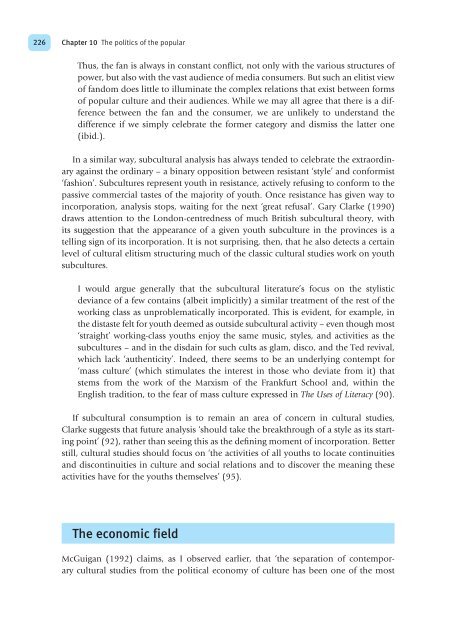Cultural Theory and Popular Culture
Cultural Theory and Popular Culture
Cultural Theory and Popular Culture
Create successful ePaper yourself
Turn your PDF publications into a flip-book with our unique Google optimized e-Paper software.
226<br />
Chapter 10 The politics of the popular<br />
Thus, the fan is always in constant conflict, not only with the various structures of<br />
power, but also with the vast audience of media consumers. But such an elitist view<br />
of f<strong>and</strong>om does little to illuminate the complex relations that exist between forms<br />
of popular culture <strong>and</strong> their audiences. While we may all agree that there is a difference<br />
between the fan <strong>and</strong> the consumer, we are unlikely to underst<strong>and</strong> the<br />
difference if we simply celebrate the former category <strong>and</strong> dismiss the latter one<br />
(ibid.).<br />
In a similar way, subcultural analysis has always tended to celebrate the extraordinary<br />
against the ordinary – a binary opposition between resistant ‘style’ <strong>and</strong> conformist<br />
‘fashion’. Subcultures represent youth in resistance, actively refusing to conform to the<br />
passive commercial tastes of the majority of youth. Once resistance has given way to<br />
incorporation, analysis stops, waiting for the next ‘great refusal’. Gary Clarke (1990)<br />
draws attention to the London-centredness of much British subcultural theory, with<br />
its suggestion that the appearance of a given youth subculture in the provinces is a<br />
telling sign of its incorporation. It is not surprising, then, that he also detects a certain<br />
level of cultural elitism structuring much of the classic cultural studies work on youth<br />
subcultures.<br />
I would argue generally that the subcultural literature’s focus on the stylistic<br />
deviance of a few contains (albeit implicitly) a similar treatment of the rest of the<br />
working class as unproblematically incorporated. This is evident, for example, in<br />
the distaste felt for youth deemed as outside subcultural activity – even though most<br />
‘straight’ working-class youths enjoy the same music, styles, <strong>and</strong> activities as the<br />
subcultures – <strong>and</strong> in the disdain for such cults as glam, disco, <strong>and</strong> the Ted revival,<br />
which lack ‘authenticity’. Indeed, there seems to be an underlying contempt for<br />
‘mass culture’ (which stimulates the interest in those who deviate from it) that<br />
stems from the work of the Marxism of the Frankfurt School <strong>and</strong>, within the<br />
English tradition, to the fear of mass culture expressed in The Uses of Literacy (90).<br />
If subcultural consumption is to remain an area of concern in cultural studies,<br />
Clarke suggests that future analysis ‘should take the breakthrough of a style as its starting<br />
point’ (92), rather than seeing this as the defining moment of incorporation. Better<br />
still, cultural studies should focus on ‘the activities of all youths to locate continuities<br />
<strong>and</strong> discontinuities in culture <strong>and</strong> social relations <strong>and</strong> to discover the meaning these<br />
activities have for the youths themselves’ (95).<br />
The economic field<br />
McGuigan (1992) claims, as I observed earlier, that ‘the separation of contemporary<br />
cultural studies from the political economy of culture has been one of the most
















